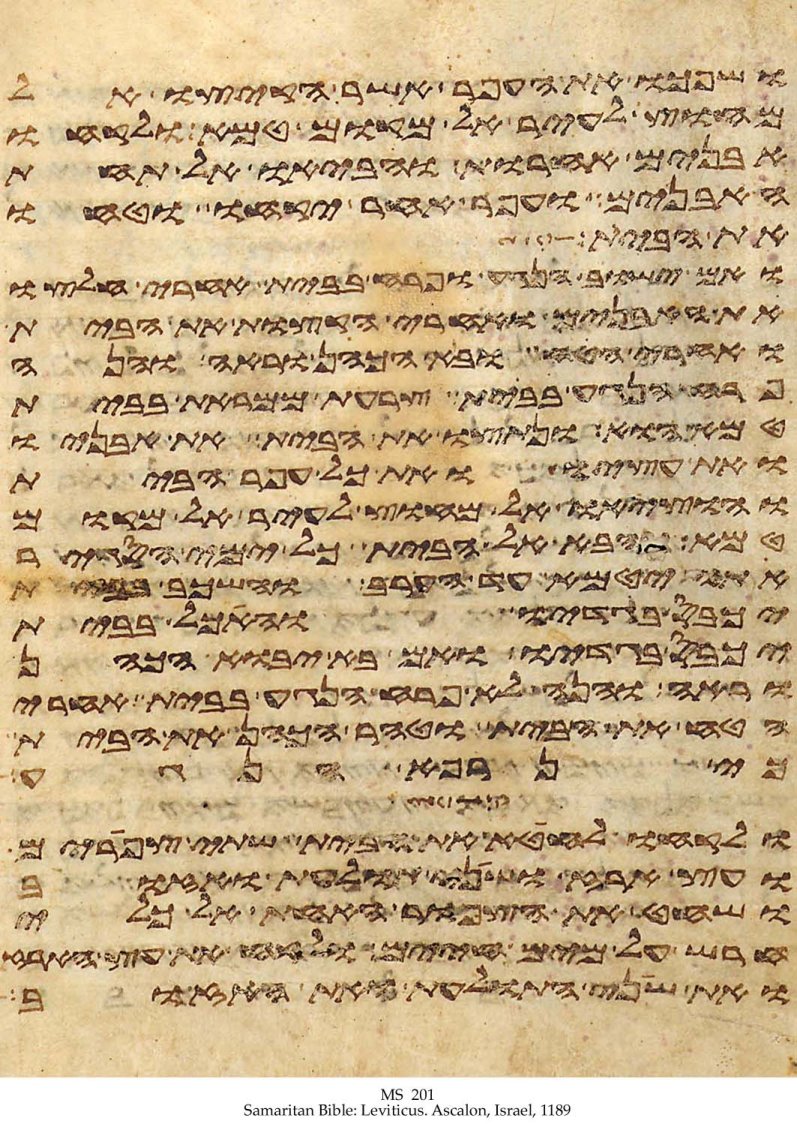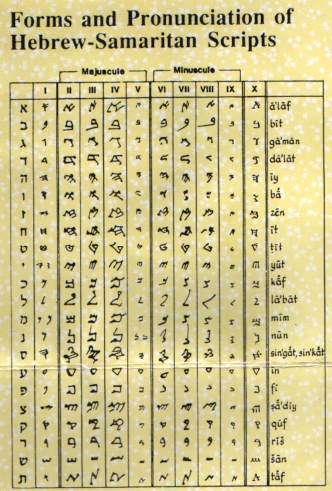THE
SAMARITAN SCRIPT
The Samaritan script
is the original ancient script of the Hebrews, unlike the modern Hebrew script
of today that originated from Babylon. The Samaritan script is the Palaeo-Hebrew
script. Still today the Samaritan script can be found on inscriptions, seals,
coins, ancient manuscripts (even from Qumran), etc.
The two
tablets of testimony were written in the correct and original Hebrew language,
and containing all the Decalogue, against whomever may transgress them or change
them or garble them.  They
were called so also, probably, because the children of Israel testified unto
themselves to accept them and to act in accordance with all of what God spoke
in Mount Sinai in their hearing and presence. Compare Exodus: “Whatever God
commanded us we will obey and do.” And that is probably why they were called
tablets of stone to indicate that they were solid and of hard nature. The meaning,
however, is deep, and God only fathoms its secrets. The writing was engraved
upon them like the engraving of a signet ring, and was done by the hand of the
Almighty. (Compare Ex. xxxi. 18, “written by the fingers of God.”) It is said
that the two tablets were the creation of God, and that their writings were
the writings of the Divine Essence.
They
were called so also, probably, because the children of Israel testified unto
themselves to accept them and to act in accordance with all of what God spoke
in Mount Sinai in their hearing and presence. Compare Exodus: “Whatever God
commanded us we will obey and do.” And that is probably why they were called
tablets of stone to indicate that they were solid and of hard nature. The meaning,
however, is deep, and God only fathoms its secrets. The writing was engraved
upon them like the engraving of a signet ring, and was done by the hand of the
Almighty. (Compare Ex. xxxi. 18, “written by the fingers of God.”) It is said
that the two tablets were the creation of God, and that their writings were
the writings of the Divine Essence.
(photo: Selection from the Samaritan
Torah)
The Samaritans did
not invent their script but inherited it. Moses received the Torah that
was handwritten by our Creator. Ex. xxiv. 12, “Ascend unto me to the mountain,
and be there: and I will give thee the two tablets, and the law and the commandments,
which I have written down for their instruction.” The words “the law” and “the
commandments” refer to the roll of the Law, which is the Torah, without the
least doubt. We can prove that this one reference found in the same book, chapter
xxxii. 32, “otherwise bolt me out from thy roll which thou hast written.” The
word Sepher, means “roll” wherever it is found, although some interpreters
render it by the word “book.” Ex. xxiv. 4, “Moses wrote down
all the words of God." Let it be known unto thee, O questioner, that the
holy Torah was revealed in one roll by the supreme righteous God, written in
the handwriting of the Almighty, in characters that are well known, containing
all the verses and divisions and commands and prohibitions and explanations
and other knowledge from the very beginning to the end. When the apostle Moses
received from God the holy roll, he placed it in his tent outside of the encampment,
and God used to speak to him after the fog had encompassed the tent and covered
the place where the holy roll was deposited. This was done there when consultation
concerning the daily affairs of the people was needed. The commandments, however,
were given to him in the tabernacle, between the two cherubim. The roll remained
in its place for forty years. It was placed by the side of the chest which Bezaleel
had prepared for the two tablets as soon as the tabernacle was erected, as we have stated before. During
the first of the eleventh month of the fortieth year, Moses began to copy the
holy law, and deposited two copies which he finished in the first month, one
with the Levites, the other with the elders. Compare Duet. xxxi. 9: “And Moses
wrote this law, and handed it to the priests, the sons of Levi, and to all the
elders of Israel.” And he taught them its content, as we find in the same chapter,
verse 19. Some say that that verse refers to all the content of the law; for,
at the end of these words, we read: “And after Moses finished writing down the
commandments of this law in the roll,” etc., he commanded the Levites to take
the roll that came from God, and place it beside the chest of the two tablets.
Compare Deut. xxxi. 26: “Take the roll of the Torah, and place it by the side
of the chest of the covenant of your God, and let it be unto thee a witness.”
And this original Torah will be a witness in the end days.
tablets as soon as the tabernacle was erected, as we have stated before. During
the first of the eleventh month of the fortieth year, Moses began to copy the
holy law, and deposited two copies which he finished in the first month, one
with the Levites, the other with the elders. Compare Duet. xxxi. 9: “And Moses
wrote this law, and handed it to the priests, the sons of Levi, and to all the
elders of Israel.” And he taught them its content, as we find in the same chapter,
verse 19. Some say that that verse refers to all the content of the law; for,
at the end of these words, we read: “And after Moses finished writing down the
commandments of this law in the roll,” etc., he commanded the Levites to take
the roll that came from God, and place it beside the chest of the two tablets.
Compare Deut. xxxi. 26: “Take the roll of the Torah, and place it by the side
of the chest of the covenant of your God, and let it be unto thee a witness.”
And this original Torah will be a witness in the end days.
As written, one the scrolls
made my Moses was given to the Levites and each Levite copied his own scroll.
The famous Abisha scroll (Sefer) of the Torah was written by Abisha, son of
Phinhas, son of Eleazer, son of Aaron, brother of Moses, in the 13th year after
the entrance of the Israelites into Canaan. The Samaritan script is used today
by the Samaritans when writing the Torah (Pentateuch), prayer books, and for
other religious purposes. Today the Samaritans in their everyday use write in
Arabic or modern Hebrew or as this website displays some English.
Home
 They
were called so also, probably, because the children of Israel testified unto
themselves to accept them and to act in accordance with all of what God spoke
in Mount Sinai in their hearing and presence. Compare Exodus: “Whatever God
commanded us we will obey and do.” And that is probably why they were called
tablets of stone to indicate that they were solid and of hard nature. The meaning,
however, is deep, and God only fathoms its secrets. The writing was engraved
upon them like the engraving of a signet ring, and was done by the hand of the
Almighty. (Compare Ex. xxxi. 18, “written by the fingers of God.”) It is said
that the two tablets were the creation of God, and that their writings were
the writings of the Divine Essence.
They
were called so also, probably, because the children of Israel testified unto
themselves to accept them and to act in accordance with all of what God spoke
in Mount Sinai in their hearing and presence. Compare Exodus: “Whatever God
commanded us we will obey and do.” And that is probably why they were called
tablets of stone to indicate that they were solid and of hard nature. The meaning,
however, is deep, and God only fathoms its secrets. The writing was engraved
upon them like the engraving of a signet ring, and was done by the hand of the
Almighty. (Compare Ex. xxxi. 18, “written by the fingers of God.”) It is said
that the two tablets were the creation of God, and that their writings were
the writings of the Divine Essence.